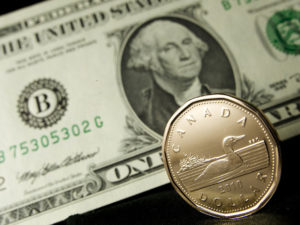 Yesterday’s trade saw USD/CAD within the range of 1.2242-1.2171. The pair closed 0.07% lower at 1.2199 after falling nearly 0.2% the previous trading session.
Yesterday’s trade saw USD/CAD within the range of 1.2242-1.2171. The pair closed 0.07% lower at 1.2199 after falling nearly 0.2% the previous trading session.
At 7:30 GMT today USD/CAD was down 0.09% for the day to trade at 1.2189. The cross held in a daily range of 1.2173 – 1.2204 and is up 1.5% for the week so far.
Fundamentals
United States
Annualized consumer inflation in the United States was probably at -0.1% in April, according to analysts expectations, following another 0.1% contraction in March and a flat reading in February due to lower energy costs which offset a jump in food prices and other items included in the core reading. In monthly terms, the Consumer Price Index (CPI) probably rose 0.1%, after jumping 0.2% in each of the previous two months.
The CPI is based on a basket of goods and services bought and used by consumers on a daily basis. In the United States, the Bureau of Labor Statistics (BLS) surveys the prices of 80 000 consumer items in order to calculate the index. The latter reflects prices of commonly purchased items by primarily urban households, which represent about 87% of the US population. The Bureau processes price data from 23 000 retail and service businesses.
The CPI includes sales taxes, but excludes income taxes, costs of investments such as stocks and bonds and sales prices of homes.
The annualized core consumer inflation, which is stripped of prices of food and energy, probably inched down to 1.7% last month from 1.8% in March and 1.7% in February. It is usually reported as a seasonally-adjusted figure because consumer patterns are widely fluctuating in dependence on the time of the year.
Core CPI is the gauge which the Federal Reserve Bank takes into account in order to adjust its monetary policy because prices of food, oil and gas are highly volatile, while the central bank’s tools are slow-acting. In case, for example, prices of gas surge considerably, this could lead to a high rate of inflation, but the central bank will not take action until this increase affects prices of other goods and services.
If the CPI tends to distance from the inflation objective set by the Federal Reserve and considered as providing price stability, this will usually reduce the appeal of the US dollar. However, quite high rates of inflation (well above the central bank’s inflation target) can be harmful to the economy, and as a result, this may lead to the loss of confidence in the local currency.
The Bureau of Labor Statistics is to release the official CPI report at 12:30 GMT.
Canada
Annualized consumer inflation in Canada probably eased to 1.0% in April, according to market expectations, from 1.2% in March. If so, this would match February and Januarys reading as the lowest since November 2013, when it was reported at 0.9%. Cheaper gasoline continued to be the largest downward contributor to the CPI in the year through March, with a 19.2% decline. In monthly terms, consumer prices probably grew by only 0.1% compared to 0.7% in March. The official CPI report by Statistics Canada is due out at 12:30 GMT.
Key categories in Canadian CPI basket are Shelter (accounting for 27.5% of the total weight) and Transportation (19.3%). Other categories include Food (with a 16.1% share), Household Operations, Furnishings and Equipment (11.8%), Recreation, Education and Reading (11.8%), Clothing and Footwear (5.7%), Health and Personal Care (5%), while Alcoholic Beverages and Tobacco Products comprise the remaining 3%.
Bank of Canadas (BoC) annualized Core CPI, which excludes prices of fruits, vegetables, gasoline, fuel oil, natural gas, mortgages, intercity transportation, and tobacco products, probably increased 2.4% last month, the same as in March. This is the key measure of inflation, on which the central bank bases its decisions regarding monetary policy.
In monthly terms, core CPI is expected at 0.2%. In case the core CPI accelerated more than projected, this would mount buying pressure on the Canadian dollar.
A separate report by the statistics agency might show that retail sales in Canada probably rose 0.3% in March on a monthly basis, according to the median forecast by experts, following a 1.7% gain in February. If not revised downwards, the latter would be the highest since May 2013. Retail sales, excluding sales of automobiles, probably expanded 0.4% in March after jumping 2.0% the preceding month. Large-ticket purchases are excluded due to their high volatility, which could influence the general trend. In case retail sales were to rise more than anticipated, this would support the Canadian dollar.
Pivot points
According to Binary Tribune’s daily analysis, the pair’s central pivot point stands at 1.2204. In case it penetrates the first resistance level at 1.2237, it will encounter next resistance at 1.2275. If breached, upside movement may attempt to advance to 1.2308.
If the cross drops below its S1 level at 1.2166, it will next see support at 1.2133. If the second key support zone is breached, downward movement may extend to 1.2095.
In weekly terms, the central pivot point is at 1.2026. The three key resistance levels are as follows: R1 – 1.2132, R2 – 1.2251, R3 – 1.2357. The three key support levels are: S1 – 1.1907, S2 – 1.1801, S3 – 1.1682.





